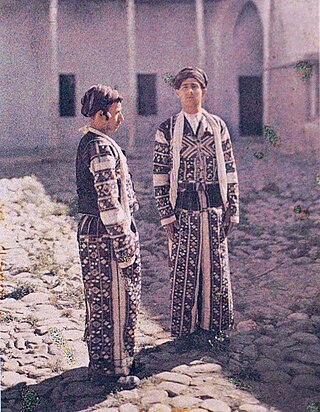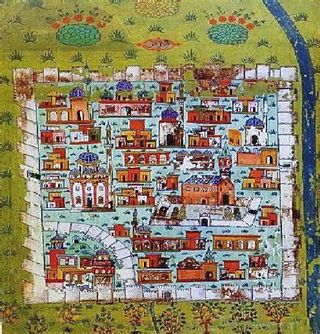
Kurdistan, or Greater Kurdistan, is a roughly defined geo-cultural region in West Asia wherein the Kurds form a prominent majority population and the Kurdish culture, languages, and national identity have historically been based. Geographically, Kurdistan roughly encompasses the northwestern Zagros and the eastern Taurus mountain ranges.

The Kurds are an Iranian ethnic group in the Middle East. They have historically inhabited the mountainous areas to the south of Lake Van and Lake Urmia, a geographical area collectively referred to as Kurdistan. Most Kurds speak Northern Kurdish Kurmanji Kurdish (Kurmanji) and Central Kurdish (Sorani).

Diyarbakır, formerly Diyarbekir, is the largest Kurdish-majority city in Turkey. It is the administrative center of Diyarbakır Province.

Ardalan was a hereditary Kurdish vassaldom in western Iran from around the 14th century until 1865 or 1868 with Sanandaj as capital. The territory corresponded roughly to present-day Kurdistan Province of Iran and the rulers were loyal to the Qajar Empire. Baban was its main rival. Gorani was the literary language and lingua franca. When the vassaldom fell, literary work in Gorani ceased.

Turkish Kurdistan or Northern Kurdistan is the southeastern part of Turkey where Kurds form the predominant ethnic group. The Kurdish Institute of Paris estimates that there are 20 million Kurds living in Turkey, the majority of them in the southeast.

Bahdinan (Bahdīnān) or Badinan (Bādīnān) was one of the most powerful and enduring Kurdish principalities. It was founded by Baha-al-Din originally from Şemzînan area in Hakkari in sometime between 13th or 14th century CE. The capital of this emirate was Amadiya for a long time. The rulers of the Bahdinan Emirate governed over the Emirate since the Abbasid Empire, an early dynasty in Islamic history.

Soran Emirate was a medieval Kurdish emirate established before the conquest of Kurdistan by Ottoman Empire in 1514 and later revived by Emir Kor centered in Rawandiz from 1816 to 1836. Kor was ousted in an offensive by the Ottomans.
Baban was a Kurdish principality existing from the 16th century to 1850, centered on Sulaymaniyah. The Baban Principality played an active role in the Ottoman-Safavid conflict and gave significant military support to the Ottomans. They were in constant rivalry with Ardalan, Bohtan and Soran and its territory would therefore oscillate. Before the removal of the last Baban leader in 1850, their rule had become limited to their capital Sulaymaniyah and few surrounding villages.

The Principality of Bitlis, also known as the Bitlis Khanate, and the Bitlis Emirate (1182–1847) was a Kurdish principality that originated from the Rojaki tribal confederation. The Rojaki defeated the Georgian King David the Curopalate and conquered Bitlis and Sasun in the 10th century. The principality occasionally came under the rule of outsiders, such as the Aq Qoyunlu and the Safavids. After the decline of the Aq Qoyunlu, the Rojaki princes asserted their independence. The principality supported the Ottoman Sultan Selim I, and in return its rulers were named Noble Khans. In 1531, the Rojaki prince withdrew his support from the Ottomans and turned towards the Safavids instead, an event that led to the capture of the principality by the Ottomans.

Bohtan was a medieval Kurdish principality in the Ottoman Empire centered on the town of Jazirah ibn 'Omar in southeastern Anatolia. The official religion of this principality was Yezidism in 14th century, although the rulers eventually converted to Islam, Bohtan constituted the third major Yezidi enclave after Shekhan and Sinjar until the 19th century.

The Eyalet of Diyarbekir was an eyalet of the Ottoman Empire. Its reported area in the 19th century was 20,332 square miles (52,660 km2), slightly larger than the original Abbasid province in Upper Mesopotamia. In 1846 it was succeeded by the Kurdistan Eyalet.
Balak, باڵەک, Balek is an ancient Kurdish tribe living in the former Soran Emirate which is now part of Erbil Governorate in Southern Kurdistan. it is located in the mountainous region of northern Erbil Governorate in Southern Kurdistan. People from the Balak area speak a language that is mixed in the Kurdish Sorani dialect and the Kurdish Kurmanji dialect.

The history of Diyarbakır, one of the largest cities in southeastern Turkey and a metropolitan municipality of Turkey, spans millennia. Diyarbakır is situated on the banks of the Tigris River. The city was first mentioned by Assyrian texts as the capital of a Semitic kingdom. It was ruled by a succession of nearly every polity that controlled Upper Mesopotamia, including the Mitanni, Arameans, Assyrians, Urartu, Armenians, Achaemenid Persians, Medes, Seleucids, and Parthians. The Roman Republic gained control of the city in the first century BC, by which stage it was named "Amida". Amida was then part of the Christian Byzantine Empire until the seventh-century Muslim conquest, after which a variety of Muslim polities gave way to the Ottoman Empire in the 16th century. It has been part of the Republic of Turkey since the dissolution of the Ottoman Empire in the early 20th century.

Zirqan Principality or Zirqans(Kurdish:Mîrîtiya Zirqan;1335-1835) was a Kurdish principality founded in Silvan in 1335 and centered in Diyarbakır Province. At the height of its power, it controlled the regions of Bitlis, Diyarbakır, and Mardin. Zirqan principality consisted of Ataq, Tercil, Gürdükan and Mihrani regions.
Süleymani Principality, established in 1520 by Seyyid Ahmed Bey Ruzeki, was a Kurdish principality. that governed the regions of Silvan and Batman. It maintained a significant political presence within the Ottoman sphere, exerting influence over the socio-political landscape of the era. However, with the Tanzimat reforms of 1839, the Süleymani Principality lost its administrative autonomy, marking the end of its era as an independent entity.
Emirate of Bradost or Emirate of Biradost was a hereditary Kurdish emirate, ruling roughly the area from Rawandiz to Targavar and Margavar south of Urmia at its height. The emirate was founded in 1510 and acted as a bufferzone between the Ottoman Empire and Safavid Iran throughout the 16th century. The emirate ultimately succumbed to the expansionist ambitions of the Ottomans and Safavids in Kurdistan.
Emirate of Çemişgezek was a hereditary and autonomous Kurdish emirate existing from the 13th century to 1663, centered around Çemişgezek including Mazgirt, Pertek and Sağman. The emirate was populated by both Muslims and non-Muslims, and moreover had a significant Kurdish Alevi population which flourished and expanded due to the secured self-governance under Ottoman rule, despite Ottoman antagonism towards the minority. Beside Kurds, the emirate had a Bozulus population. According to Sharafnama, the 12–13th-century rulers of the emirate were of Turkic origin.

Ottoman Kurds were ethnic Kurds who lived in the Ottoman Empire. At its peak, the Ottoman Empire ruled Turkish Kurdistan, Iraqi Kurdistan, Syrian Kurdistan, and a small part of Iranian Kurdistan.

Ottoman Kurdistan refers to areas of Kurdistan which were part of the Ottoman Empire. During the Ottoman Empire's peak they controlled all of modern-day Turkish Kurdistan, Iraqi Kurdistan, and Syrian Kurdistan, as well as a small part of Iranian Kurdistan. The term "Kurdistan" was used regularly by Ottoman officials to refer to its regions where Kurds made up a majority, and was included on many maps.









